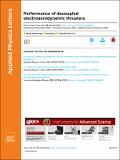Performance of decoupled electroaerodynamic thrusters
Author(s)
Gomez-Vega, Nicolas; Xu, Haofeng; Abel, James M; Barrett, Steven RH
DownloadPublished version (1.348Mb)
Publisher with Creative Commons License
Publisher with Creative Commons License
Creative Commons Attribution
Terms of use
Metadata
Show full item recordAbstract
Solid-state aerodynamic devices, which use electroaerodynamics (EAD) to produce a propulsive force, have the potential to make drones and airplanes significantly quieter and may provide benefits in sustainability and manufacturability. In these devices, ions are accelerated between two electrodes by an electric field, colliding with neutral air molecules and producing an ionic wind and a thrust force. The authors' previous work showed that a "decoupled"device architecture, which separates the ionization and ion acceleration processes, can increase thrust density and thrust-to-power compared to the prevailing corona-discharge-based EAD architecture, which uses a single DC potential for both processes. However, the discharge characteristics of this decoupled architecture have not been previously determined. Here, we experimentally characterize a decoupled EAD thruster with a wire-to-wire dielectric barrier discharge (DBD) ion source: an AC voltage drives the DBD, which ionizes neutral air molecules at the emitting electrode, while a separate DC voltage accelerates ions toward the collecting electrode. We determine the discharge characteristics (i.e., the DC-current-to-DC-voltage relationship) of this decoupled thruster as well as a model for the interaction between the ionization and acceleration stages: we find that the former takes the same functional form as the analytical solution for space-charge limited current in a thin collisional ion channel, whereas the latter is determined primarily by the power draw of the DBD ionization stage. We present a complete model for the thrust and power draw of decoupled EAD thrusters, enabling their quantitative design and optimization for use in aircraft propulsion and other applications.
Date issued
2021Department
Massachusetts Institute of Technology. Department of Aeronautics and AstronauticsJournal
Applied Physics Letters
Publisher
AIP Publishing
Citation
Gomez-Vega, Nicolas, Xu, Haofeng, Abel, James M and Barrett, Steven RH. 2021. "Performance of decoupled electroaerodynamic thrusters." Applied Physics Letters, 118 (7).
Version: Final published version